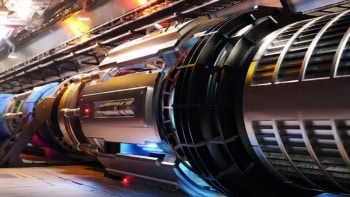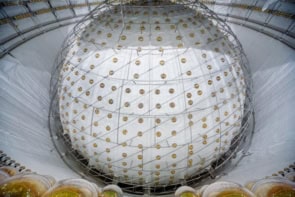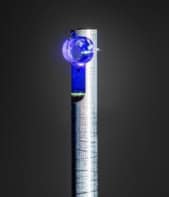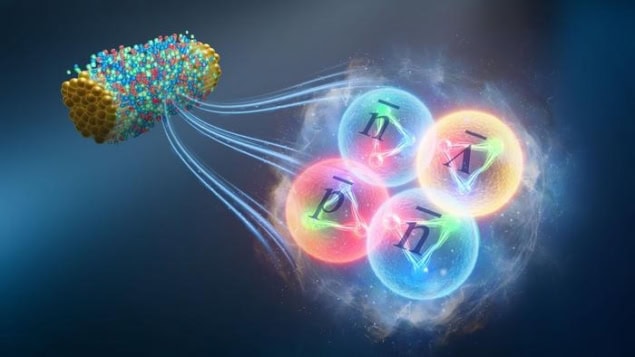
An antihyperhydrogen-4 nucleus – the heaviest antinucleus ever produced – has been observed in heavy ion collisions by the STAR Collaboration at Brookhaven National Laboratory in the US. The antihypernucleus contains a strange quark, making it a heavier cousin of antihydrogen-4. Physicists hope that studying such antimatter particles could shed light on why there is much more matter than antimatter in the visible universe – however in this case, nothing new beyond the Standard Model of particle physics was observed.
In the first millionth of a second after the Big Bang, the universe is thought to have been too hot for quarks to have been bound into hadrons. Instead it comprised a strongly interacting fluid called a quark–gluon plasma. As the universe expanded and cooled, bound baryons and mesons were created.
The Standard Model forbids the creation of matter without the simultaneous creation of antimatter, and yet the universe appears to be made entirely of matter. While antimatter is created by nuclear processes – both naturally and in experiments – it is swiftly annihilated on contact with matter.
The Standard Model also says that matter and antimatter should be identical after charge, parity and time are reversed. Therefore, finding even tiny asymmetries in how matter and antimatter behave could provide important information about physics beyond the Standard Model.
Colliding heavy ions
One way forward is to create quark–gluon plasma in the laboratory and study particle–antiparticle creation. Quark–gluon plasma is made by smashing together heavy ions such as lead or gold. A variety of exotic particles and antiparticles emerge from these collisions. Many of them decay almost immediately, but their decay products can be detected and compared with theoretical predictions.
Quark–gluon plasma can include hypernuclei, which are nuclei containing one or more hyperons. Hyperons are baryons containing one or more strange quarks, making hyperons the heavier cousins of protons and neutrons. These hypernuclei are thought to have been present in the high-energy conditions of the early universe, so physicists are keen to see if they exhibit any matter/antimatter asymmetries.
In 2010, the STAR collaboration unveiled the first evidence of an antihypernucleus, which was created by smashing gold nuclei together at 200 GeV. This was the antihypertriton, which is the antimatter version of an exotic counterpart to tritium in which one of the down quarks in one of the neutrons is replaced by a strange quark.
Now, STAR physicists have created a heavier antihypernucleus. They recorded over 6 billion collisions using pairs of uranium, ruthenium, zirconium and gold ions moving at more than 99.9% of the speed of light. In the resulting quark–gluon plasma, the researchers found evidence of antihyperhydrogen-4 (antihypertriton with an extra antineutron). Antihyperhydrogen-4 decays almost immediately by the emission of a pion, producing antihelium-4. This was detected by the researchers in 2011. The researchers therefore knew what to look for among the debris of their collisions.
Sifting through the collisions
Sifting through the collision data, the researchers found 22 events that appeared to be antihyperhydrogen-4 decays. After subtracting the expected background, they were left with approximately 16 events, which was statistically significant enough to claim that they had observed antihyperhydrogen-4.
The researchers also observed evidence of the decays of hyperhydrogen-4, antihypertriton and hypertriton. In all cases, the results were consistent with the predictions of charge–parity–time (CPT) symmetry. This is a central tenet of modern physics that says that if the charge and internal quantum numbers of a particle are reversed, the spatial co-ordinates are reversed and the direction of time is reversed, the outcome of an experiment will be identical.
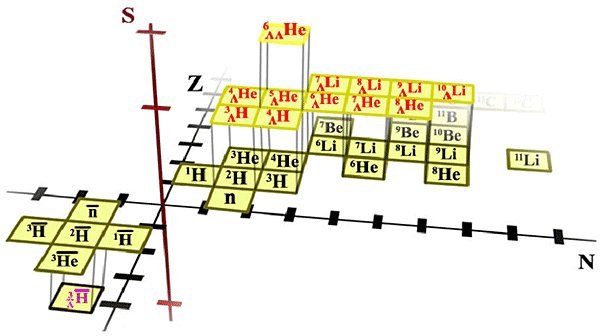
RHIC nets strange antimatter
STAR member Hao Qiu of the Institute of Modern Physics at the Chinese Academy of Sciences says that, in his view, the most important feature of the work is the observation of the hyperhydrogen-4. “In terms of the CPT test, it’s just that we’re able to do it…The uncertainty is not very small compared with some other tests.”
Qiu says that he, personally, hopes the latest research may provide some insight into violation of charge–parity symmetry (i.e. without flipping the direction of time). This has already been shown to occur in some systems. “Ultimately, though, we’re experimentalists – we look at all approaches as hard as we can,” he says; “but if we see CPT symmetry breaking we have to throw out an awful lot of current physics.”
“I really do think it’s an incredibly impressive bit of experimental science,” says theoretical nuclear physicist Thomas Cohen of University of Maryland, College Park; “The idea that they make thousands of particles each collision, find one of these in only a tiny fraction of these events, and yet they’re able to identify this in all this really complicated background – truly amazing!”
He notes, however, that “this is not the place to look for CPT violation…Making precision measurements on the positron mass versus the electron mass or that of the proton versus the antiproton is a much more promising direction simply because we have so many more of them that we can actually do precision measurements.”
The research is described in Nature.
